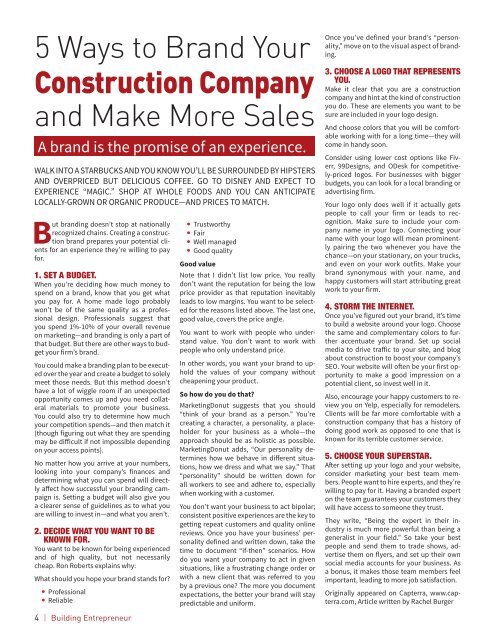Building_Entrepreneur_to print
You also want an ePaper? Increase the reach of your titles
YUMPU automatically turns print PDFs into web optimized ePapers that Google loves.
5 Ways <strong>to</strong> Brand Your<br />
Construction Company<br />
and Make More Sales<br />
A brand is the promise of an experience.<br />
WALK INTO A STARBUCKS AND YOU KNOW YOU’LL BE SURROUNDED BY HIPSTERS<br />
AND OVERPRICED BUT DELICIOUS COFFEE. GO TO DISNEY AND EXPECT TO<br />
EXPERIENCE “MAGIC.” SHOP AT WHOLE FOODS AND YOU CAN ANTICIPATE<br />
LOCALLY-GROWN OR ORGANIC PRODUCE—AND PRICES TO MATCH.<br />
But branding doesn’t s<strong>to</strong>p at nationally<br />
recognized chains. Creating a construction<br />
brand prepares your potential clients<br />
for an experience they’re willing <strong>to</strong> pay<br />
for.<br />
1. SET A BUDGET.<br />
When you’re deciding how much money <strong>to</strong><br />
spend on a brand, know that you get what<br />
you pay for. A home made logo probably<br />
won’t be of the same quality as a professional<br />
design. Professionals suggest that<br />
you spend 1%-10% of your overall revenue<br />
on marketing—and branding is only a part of<br />
that budget. But there are other ways <strong>to</strong> budget<br />
your firm’s brand.<br />
You could make a branding plan <strong>to</strong> be executed<br />
over the year and create a budget <strong>to</strong> solely<br />
meet those needs. But this method doesn’t<br />
have a lot of wiggle room if an unexpected<br />
opportunity comes up and you need collateral<br />
materials <strong>to</strong> promote your business.<br />
You could also try <strong>to</strong> determine how much<br />
your competition spends—and then match it<br />
(though figuring out what they are spending<br />
may be difficult if not impossible depending<br />
on your access points).<br />
No matter how you arrive at your numbers,<br />
looking in<strong>to</strong> your company’s finances and<br />
determining what you can spend will directly<br />
affect how successful your branding campaign<br />
is. Setting a budget will also give you<br />
a clearer sense of guidelines as <strong>to</strong> what you<br />
are willing <strong>to</strong> invest in—and what you aren’t.<br />
2. DECIDE WHAT YOU WANT TO BE<br />
KNOWN FOR.<br />
You want <strong>to</strong> be known for being experienced<br />
and of high quality, but not necessarily<br />
cheap. Ron Roberts explains why:<br />
What should you hope your brand stands for?<br />
• yProfessional<br />
• yReliable<br />
4 | <strong>Building</strong> <strong>Entrepreneur</strong><br />
• yTrustworthy<br />
• yFair<br />
• yWell managed<br />
• yGood quality<br />
Good value<br />
Note that I didn’t list low price. You really<br />
don’t want the reputation for being the low<br />
price provider as that reputation inevitably<br />
leads <strong>to</strong> low margins. You want <strong>to</strong> be selected<br />
for the reasons listed above. The last one,<br />
good value, covers the price angle.<br />
You want <strong>to</strong> work with people who understand<br />
value. You don’t want <strong>to</strong> work with<br />
people who only understand price.<br />
In other words, you want your brand <strong>to</strong> uphold<br />
the values of your company without<br />
cheapening your product.<br />
So how do you do that?<br />
MarketingDonut suggests that you should<br />
“think of your brand as a person.” You’re<br />
creating a character, a personality, a placeholder<br />
for your business as a whole—the<br />
approach should be as holistic as possible.<br />
MarketingDonut adds, “Our personality determines<br />
how we behave in different situations,<br />
how we dress and what we say.” That<br />
“personality” should be written down for<br />
all workers <strong>to</strong> see and adhere <strong>to</strong>, especially<br />
when working with a cus<strong>to</strong>mer.<br />
You don’t want your business <strong>to</strong> act bipolar;<br />
consistent positive experiences are the key <strong>to</strong><br />
getting repeat cus<strong>to</strong>mers and quality online<br />
reviews. Once you have your business’ personality<br />
defined and written down, take the<br />
time <strong>to</strong> document “if-then” scenarios. How<br />
do you want your company <strong>to</strong> act in given<br />
situations, like a frustrating change order or<br />
with a new client that was referred <strong>to</strong> you<br />
by a previous one? The more you document<br />
expectations, the better your brand will stay<br />
predictable and uniform.<br />
Once you’ve defined your brand’s “personality,”<br />
move on <strong>to</strong> the visual aspect of branding.<br />
3. CHOOSE A LOGO THAT REPRESENTS<br />
YOU.<br />
Make it clear that you are a construction<br />
company and hint at the kind of construction<br />
you do. These are elements you want <strong>to</strong> be<br />
sure are included in your logo design.<br />
And choose colors that you will be comfortable<br />
working with for a long time—they will<br />
come in handy soon.<br />
Consider using lower cost options like Fiverr,<br />
99Designs, and ODesk for competitively-priced<br />
logos. For businesses with bigger<br />
budgets, you can look for a local branding or<br />
advertising firm.<br />
Your logo only does well if it actually gets<br />
people <strong>to</strong> call your firm or leads <strong>to</strong> recognition.<br />
Make sure <strong>to</strong> include your company<br />
name in your logo. Connecting your<br />
name with your logo will mean prominently<br />
pairing the two whenever you have the<br />
chance—on your stationary, on your trucks,<br />
and even on your work outfits. Make your<br />
brand synonymous with your name, and<br />
happy cus<strong>to</strong>mers will start attributing great<br />
work <strong>to</strong> your firm.<br />
4. STORM THE INTERNET.<br />
Once you’ve figured out your brand, it’s time<br />
<strong>to</strong> build a website around your logo. Choose<br />
the same and complementary colors <strong>to</strong> further<br />
accentuate your brand. Set up social<br />
media <strong>to</strong> drive traffic <strong>to</strong> your site, and blog<br />
about construction <strong>to</strong> boost your company’s<br />
SEO. Your website will often be your first opportunity<br />
<strong>to</strong> make a good impression on a<br />
potential client, so invest well in it.<br />
Also, encourage your happy cus<strong>to</strong>mers <strong>to</strong> review<br />
you on Yelp, especially for remodelers.<br />
Clients will be far more comfortable with a<br />
construction company that has a his<strong>to</strong>ry of<br />
doing good work as opposed <strong>to</strong> one that is<br />
known for its terrible cus<strong>to</strong>mer service.<br />
5. CHOOSE YOUR SUPERSTAR.<br />
After setting up your logo and your website,<br />
consider marketing your best team members.<br />
People want <strong>to</strong> hire experts, and they’re<br />
willing <strong>to</strong> pay for it. Having a branded expert<br />
on the team guarantees your cus<strong>to</strong>mers they<br />
will have access <strong>to</strong> someone they trust.<br />
They write, “Being the expert in their industry<br />
is much more powerful than being a<br />
generalist in your field.” So take your best<br />
people and send them <strong>to</strong> trade shows, advertise<br />
them on flyers, and set up their own<br />
social media accounts for your business. As<br />
a bonus, it makes those team members feel<br />
important, leading <strong>to</strong> more job satisfaction.<br />
Originally appeared on Capterra, www.capterra.com,<br />
Article written by Rachel Burger







